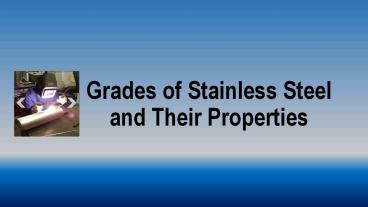Grades of Stainless Steel and Their Properties - PowerPoint PPT Presentation
Title:
Grades of Stainless Steel and Their Properties
Description:
t is graded according to its chemical composition, and therefore its differing properties. It is important to become familiar with the main types of, as one steel is likely to be more suitable than another for a specific purpose. In general, while stainless steel can resist many types of corrosion, all grades are likely to be corroded by chlorides, with those grades which are high in chromium, molybdenum and nickel exhibiting the most resistance. Similarly, while some steel is entirely non-magnetic, other types retain their magnetic attraction. – PowerPoint PPT presentation
Number of Views:91
Title: Grades of Stainless Steel and Their Properties
1
Grades of Stainless Steel and Their Properties
2
Properties and uses of 200 series 200 series
stainless steel is non magnetic, and made up of
approximately 17 chromium, 4 nickel and 7
manganese. Less common than the 300 series grade,
to which it is most similar, it is most often
used for knives and cooking utensils. It retains
strength at high temperatures, and is less prone
to attack from corrosion than the 300 series.
Once corrosion has begun, however, it often
breaks down rapidly. While it can withstand
immersion in environments such as seawater, it
cannot do so indefinitely, with some corrosion
beginning within months.
3
Properies and uses of 300 series 300 series
stainless steel is also non magnetic, and makes
up over 70 of total stainless steel production.
As such it can be found in use across a range of
applications, including domestic architecture and
construction of planes, trains and automobiles.
Consisting of approximately 18 chromium and 8
nickel, it is also often used in kitchen utensils
and catering equipment, and is similar in its
corrosion resisting properties to the 200 series.
If used in environments without high chloride
content, it is extremely proficient at resisting
corrosion, but where chloride levels are high,
performance will rapidly decline.
4
Properties and uses of 400 series Unlike the 200
and 300 series, 400 series stainless steel is
magnetic. Containing approximately 11 chromium
and 1 manganese, this series responds well to
hardening through heat, but has poor resistance
to corrosion. Unless protected, 400 series is not
practical for any kind of seawater application.
It is most commonly used in applications which
require heat resistance, such as exhaust pipes,
heat exchangers, combustion burners and so on. It
should not be used in low temperature
environments, as its strength drops rapidly in
this situation.
5
Properties and uses of 600 series In a similar
fashion to the 400 series, 600 series stainless
steel can be heat treated to extremely high
strength levels (leading to the common reference
to this series as 'precipitation hardening' ),
exhibiting tensile strength of up to double the
300 series. It also retains its magnetism.
Vulnerable to chloride environments, 600 series
is also vulnerable to stress cracking when
corroded. Most 600 series can only remain in
seawater without corrosion for a few days.
Similarly to the 400 series, this type should not
be used in low temperatures.
Image http//www.msstainless.com.au/
Source http//ezinearticles.com/6994959

